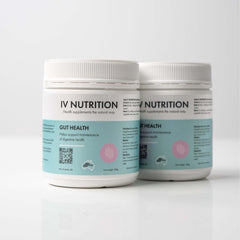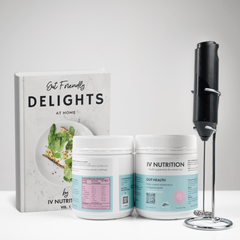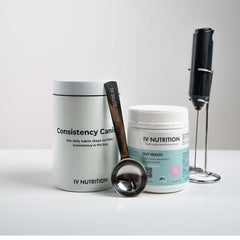How to Flush Bowels Quickly? A Science-Backed, Natural Guide to Getting Things Moving
Let’s face it: there are few things more frustrating than the sluggish, bloated feeling that comes with a backed-up bowel. Whether you’re prepping for a fresh start, recovering from a dietary detour, or simply want to feel lighter and more energized, you’ve probably asked:
“How do I flush my bowels quickly?”
Spoiler alert: There’s no magic button. But there are science-backed strategies—from hydration hacks and high-fiber foods to microbiome magic—that can give your digestive system the reboot it’s begging for.
In this guide, we’ll walk you through:
-
What “flushing” your bowels really means (and doesn’t)
-
The safest and most effective ways to do it
-
Lifestyle and nutrition tips that work fast and keep things moving
-
A gut-loving secret weapon: prebiotic fiber
-
And an exclusive offer to try IV Nutrition’s virgin sugarcane prebiotic fiber—for FREE
Let’s go (pun intended).
🚽 First, What Does It Mean to “Flush” Your Bowels?
We’re not talking about laxative overkill, explosive cleanses, or those social media “colon detox” gimmicks.
Clinically speaking, flushing your bowels means stimulating the digestive system to promote complete and efficient elimination of waste from the colon.
This process can:
-
Relieve bloating
-
Improve mental clarity (via the gut-brain axis)
-
Boost immune function
-
Improve energy and reduce fatigue
-
Reset your digestive rhythm
And it doesn’t require harsh chemicals, starvation diets, or bathroom marathons. Just a little knowledge, consistency, and the right ingredients.
🧬 The Science Behind Bowel Motility
Your colon is a muscle. Its job is to absorb water, ferment undigested fiber, and move waste through peristalsis (muscle contractions).
What you eat, drink, and do every day determines:
-
How fast things move
-
How complete the evacuation is
-
Whether you feel light and clean—or backed up and bloated
When bowel motility slows, stool can become dry and difficult to pass. This leads to that sluggish, uncomfortable, “I need to go but I can’t” feeling.
✅ Top 7 Clinically Proven Ways to Flush Your Bowels Fast
1. 💧 Drink Warm Water First Thing in the Morning
Warm water (especially with lemon) can stimulate gastrointestinal motility by waking up the enteric nervous system.
Try: A mug of warm water with a squeeze of lemon juice on an empty stomach.
📚 Source: European Journal of Gastroenterology & Hepatology
2. 🏃♀️ Get Moving—Literally
Physical activity is one of the fastest ways to stimulate peristalsis. Even light exercise helps your intestines contract more effectively.
Try: A brisk 15-minute walk, yoga, or gentle stretching.
3. 🥬 Load Up on Prebiotic Fiber
Here’s the secret sauce: prebiotic fiber is a type of plant-based fiber your body can’t digest—but your good gut bacteria love it. Once fermented in the colon, it produces short-chain fatty acids (like butyrate) that improve motility, reduce inflammation, and stimulate natural bowel movements.
Unlike stimulant laxatives, prebiotic fiber works with your gut, not against it.
We’ll talk more about the best prebiotic option—IV Nutrition’s Virgin Sugarcane Prebiotic Fiber—in a moment. Stay tuned.
📚 ISAPP Science: Prebiotics and Gut Health
4. 🧂 Add Magnesium-Rich Foods (or Supplements)
Magnesium citrate or magnesium oxide can draw water into the intestines, softening stool and triggering movement.
Food sources include: spinach, pumpkin seeds, almonds, and avocados.
5. 🥣 Try a Fiber-Rich Breakfast
A high-fiber breakfast gets your gut activated for the day ahead. Insoluble fiber (from whole grains and veggies) bulks the stool, while soluble fiber softens it.
Example breakfast: Oatmeal with chia seeds, berries, and a scoop of prebiotic fiber.
6. 💆♂️ Stimulate the Vagus Nerve
The vagus nerve connects your brain to your digestive tract. You can stimulate it by:
-
Deep belly breathing
-
Gargling
-
Cold exposure (like splashing cold water on your face)
-
Singing or humming
This activates the parasympathetic nervous system, encouraging digestion.
7. 🚽 Use the Proper Toilet Posture
The “Western” toilet position doesn’t allow your colon to fully relax.
Try: Elevating your feet using a small stool. This mimics the natural squatting position, straightening the rectum and making elimination smoother.
🚀 The Fastest Natural Way? Feed Your Gut With Prebiotic Fiber
While hydration, movement, and posture help in the moment, real change happens at the microbial level.
Why Prebiotics Are Game-Changers
Unlike harsh laxatives, prebiotics gently stimulate bowel movement by:
-
Feeding beneficial gut bacteria
-
Increasing stool bulk and water content
-
Supporting consistent, complete elimination
-
Reducing gut inflammation and bloating
And they’re backed by decades of clinical research.
🌿 Meet Your Gut’s Best Friend: IV Nutrition’s Virgin Sugarcane Prebiotic Fiber
If you’re serious about regular, natural bowel movements without side effects, this is the fiber to try.
What Makes It Special?
✅ Virgin sugarcane fiber – Not processed or bleached; rich in naturally occurring polyphenols
✅ Dual-action – Contains both soluble and insoluble fiber
✅ Prebiotic support – Fuels butyrate-producing bacteria
✅ Low FODMAP – Ideal for sensitive tummies
✅ Easy to use – Tasteless, odorless, dissolves in water, tea, or smoothies
Whether you’re flushing your system or maintaining long-term bowel health, this is one supplement worth the scoop.
🎁 Special Offer: Try It FREE (Yes, Really)
Want to give your gut the love it deserves—risk-free?
IV Nutrition is offering 100% off your first tub of their Virgin Manufactured Sugarcane Prebiotic Fiber when you subscribe.
No gimmicks. Just smoother mornings, a lighter you, and a healthier microbiome.
💩 What Should a Healthy Bowel Movement Look Like?
According to the Bristol Stool Chart, aim for:
-
Type 3: Like a sausage with cracks
-
Type 4: Smooth and snake-like
Avoid:
-
Type 1 & 2: Hard and lumpy = constipated
-
Type 6 & 7: Mushy or watery = diarrhea or irritation
📚 Learn more: Bristol Stool Chart
🛑 When to See a Doctor
While occasional constipation is common, chronic or severe symptoms may signal an underlying issue.
Seek medical advice if you experience:
-
No bowel movement for more than 7 days
-
Blood in your stool
-
Unexplained weight loss
-
Persistent bloating or cramping
-
Nausea or vomiting
📅 One-Day Bowel Flush Plan (Quick Guide)
Want a gentle, natural flush without drastic measures?
Here’s your plan:
| Time | Action |
|---|---|
| 7:00 AM | Warm lemon water |
| 8:00 AM | High-fiber breakfast + scoop of prebiotic fiber |
| 9:00 AM | 20-minute walk |
| 11:00 AM | Herbal tea (peppermint or ginger) |
| 12:30 PM | Magnesium-rich lunch (quinoa, spinach, beans) |
| 2:00 PM | Deep breathing or vagus nerve stimulation |
| 6:00 PM | Light dinner + fiber |
| 8:00 PM | Scoop of prebiotic fiber in warm tea or water |
✨ Final Thoughts: Flushing Doesn’t Have to Be Forceful
Flushing your bowels isn’t about quick fixes or bathroom panic. It’s about supporting your body with science-backed practices that work with your system—not against it.
The real heroes?
-
Water
-
Movement
-
Toilet posture
-
And prebiotic fiber—especially from clean, natural sources like virgin sugarcane
Give your body what it needs. You’ll feel lighter, clearer, and more in sync with your gut—naturally.
👉 Grab your FREE tub of IV Nutrition’s Virgin Sugarcane Prebiotic Fiber here





